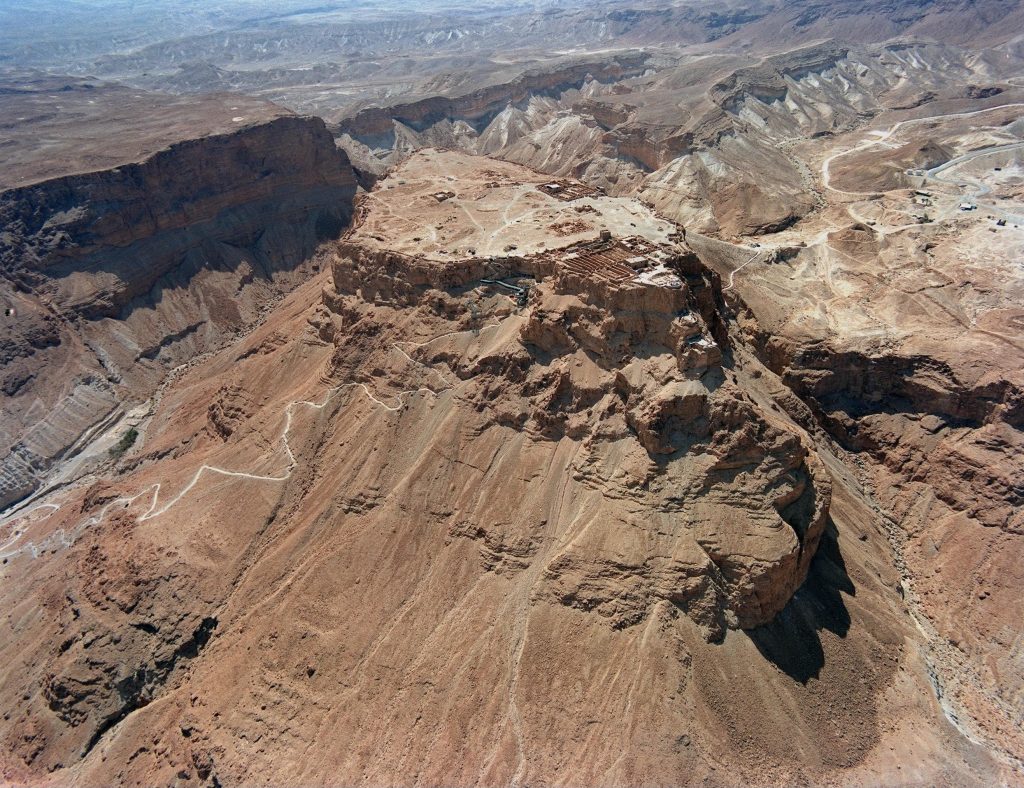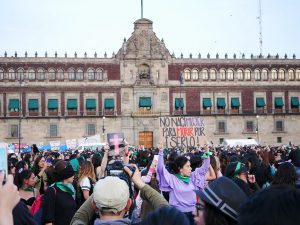Masada was an impressive fortress built upon a plateau to protect Jewish Zealots and refugees from the Romans. The Jews wisely chose this location because of its natural defenses against invaders. They imagined it would be impossible for anyone to besiege the city; the treacherous terrain and great outer wall surrounding Masada surely would protect it. Unfortunately, the Jews underestimated the Roman army.

Masada appeared to be the perfect fortress. Its four vertical sides made it nearly impossible to invade. The largest wall on the eastern side is one hundred forty meters above the desert floor, roughly half the size of the Eiffel Tower. From the east, there is a dangerous zig-zagging trail called the serpent’s path. The western side wall is eighty meters above the desert floor, as tall as the Statue of Liberty. The inhabitants took the extra precaution and built two walls on the perimeter of the plateau about 1400 meters long and six meters tall. The outer wall was 1.4 meters thick and the inner was 1 meter thick. Between the inner and outer wall, there was an empty space. During an invasion they planned to fill the gap with stone, wood, and dirt to strengthen the wall; until then it was used for storage. There were also twenty-meter-tall towers strategically spaced out throughout Masada for defensive reasons.1
The defenders were aware that if one were to attack, the first action the enemy would take would be to stop the water supply. Anticipating that possibility, the defenders built twelve cisterns to hold the water inside the fortress. Along the western slopes they had enough water stored to fill sixteen Olympic pools. It was very forward thinking of the Jews to do this. They also had many food storehouses toward the north. They kept grain, oils, corn, wine, dates, along with other foods. Thanks to the dry climate, storing the food was not a problem. In case they were to run low, the flat land would be ideal to grow additional food. Remains of the wall, tower, cisterns, food storage buildings, and other structures are still visible today.1

Unfortunately, these precautions were no match for the Roman army. In 73 C.E., Flavius Silva marched the Roman army and other troops totaling about 10,000 soldiers south to conquer Masada. Waiting on top of Masada were the 1,000 men (Jewish refugees and Zealots) willing to defend their safe haven. The Romans were aware it would take a significant amount of time to destroy Masada, so they set up camp and had Jewish war prisoners bring a constant supply of food and water. They first stopped up the aqueducts and diverted them for their own use. Next, they constructed a wall around Masada to prevent the inhabitants from escaping, and to cut them off from the outside world, a classic Roman war operation. The wall was three meters high and 3.2 kilometers long, and enforced by eight camps with many other guards posted. This impressive mechanism was built in a matter of days and can still be seen today.1

The Romans knew this would not be a quick victory; they would have to overthrow Masada by force. They came to the conclusion that the only way to reach the top of Masada was by making the steep side into a gradual incline. To do this, they took advantage of a natural spur called the white rock on the western side. It was nearly two hundred meters from the top of Masada to the edge of the natural gulf. The ramp to the top was built at a twenty degree incline. It took months to build the massive ramp. Every day, the inhabitants of Masada would wake up to see the enemy growing closer and closer, with no way for them to escape. As the Romans got close to the top, they became more vulnerable to the defenders. The Jews at the top could now shoot arrows and defend themselves against the Romans. As a result, the Romans had the Jewish war prisoners shield them so that they could shoot back. Within two months, the great ramp was complete. It was two hundred twenty meters long, and archaeologists assume it weighed as much as one and a half empire state buildings.4
The Romans attacked Masada with their siege towers. They rolled the massive towers up the man-made ramp to overthrow Masada. The inhabitants tried to fight back, shooting arrows at the towers and trying to destroy it with fire.4 The day before the final attack, the Romans carefully planned how they would conquer Masada. Early that morning, they charged up the ramp, and over the walls. To their surprise, they were not met with a fight. Instead, they encountered thousands of dead bodies. The few remaining women and children explained to them what had happened. The Jews knew they did not stand a chance against the Roman army of 10,000. They decided it would be better to die than to be conquered. Since Judaism does not allow suicide, they came to the conclusion they would have to kill each other. The men first killed the children and women; then they cast lots to decide who would be killed first, and who would have to be the last to commit suicide. It is ironic how they ignored the sixth commandment not to murder, but decided to alter its meaning to mean not to murder yourself. Despite the confusion, they ultimately chose death over slavery.6
- Encyclopedia Judea, 2007, s.v. “Masada,” by Michael Berenbaum. ↵
- Encyclopedia Judea, 2007, s.v. “Masada,” by Michael Berenbaum. ↵
- Encyclopedia Judea, 2007, s.v. “Masada,” by Michael Berenbaum. ↵
- The Greenhaven Encyclopedia of the Ancient World, 2002, s.v. “Siege of Masada,” by Don Nardo. ↵
- The Greenhaven Encyclopedia of the Ancient World, 2002, s.v. “Siege of Masada,” by Don Nardo. ↵
- Encyclopedia of Death & Human Experiences, 2009, s.v. “Mass Suicide,” by Clifton D. Bryant. ↵



86 comments
Johnanthony Hernandez
Great article, I don’t think that it was a defiance of the Sixth Commandment that they shall not murder but more a a last ditch effort to die as free people at the hands of fellow free individuals. But it makes me think what were the thoughts of the Romans when they came across the bodies of the citizens of Masada. Were they ready for what they saw and it makes me think, could the Romans admire the Jews bravery to die and face damnation for their actions rather than go back into slavery.
Samuel Sanchez
Very interesting article. I did not know about the city of Masada but wow it well crafted in terms of defense. It was nearly perfect when in came on the defense but up against the Romans anything can get conquered and they proved it. Shows you despite genius the Romans were. The title was kind of misleading at first because you started talking about the city on how it was built to keep the Jews safe but I guess you had to read it to all the way through. Overall great article. Keep up the great work.
Steven Clinton
Interesting article, The mass suicide of Masada seems to be an unavoidable event; the Romans sieged the Masada with the intent of slaughtering all the Jews within the fortress. It’s unfortunate that Jews committed mass suicide, but they had no options. I wonder how the Jews came to the decision to manipulate the sixth commandment, not to murder. Again interesting article.
Ximena Acosta
The Masada is such an interesting event I wish I would of learned about earlier. You wrote this article well! It was very easy to follow along to the story. Although the Roman army knew how to overthrow the fortress, I believe the Jews created a masterpiece. They strategically formed their sanctuary and were very prepared. I believe their massive suicide at the end made sense since they would of had to go from living comfortably and free to being prisoners.
Natalia Zuniga
Interesting Article! I never knew about Masada, let alone the mass suicide. It was interesting on the reason for it and also how they thought of how such location could benefit them. The photograph of modern-day Masada was great, as well as your graphic of the map of Masada gave me a better visual not to mention the photo of the Roman camp. Overall great article!
Nahim Rancharan
This was an excellent article! I like the fact that although it contained a lot of historical facts and information, it was made easier to follow given that you provided modern day comparisons when you were describing the measurements for the different types of infrastructure constructed during this time. Additionally, it was fascinating how you were able to captivate the ingenuity possessed by both the Jews and the Romans in either sustaining/defending themselves or coming up with military tactics respectively. It was interesting even more so due to the fact that these people didn’t have access to our modern technology, which was a very important highlight in your article. All-in-all, the article was well organized and you presented the information in a concise yet captivating manner. Great Work!
Priscilla Reyes
Interesting choice of topic! The whole thing sounds like a movie to me! The introduction was captivating and I liked the mention of the Eiffel Tower and the Statue of Liberty in a following paragraph.
I imagine the thoughts of the Jews as they saw their enemy approaching. It is admirable that they did not give up at first and I was surprised of the outcome. I understand drastic measures were taken, because they might have felt desperate, but I agree that their actions were contradicting.
Ana Gonzalez
I had never heard of Masada before and it’s a very interesting topic. You did a great job organizing your article so it was easy to follow and it was also well-written. Great job! I think it’s amazing how the Jews were able to built this fortress to keep out the Romans. It was very ingenious of them to store water and food in case they were ever surrounded and resources were cut short. The ending to this story is so tragic and poetic. It’s crazy the measures that the Romans would go to invade the Jews and their willingness to wait out the Jews. I can’t even imagine the hopelessness the Jews must have felt. Great job!
Cesar Zavala
This was my first time hearing about this battle of Masada. It seems like the battle took a long period of time due to the heavy defenses that Masada had as well as the height advantage they had over the Romans. Although the Roman’s tactic to get up closer to the wall was ingenious, I believe that the way they used the captive Jewish people as body shields is nothing short of evil and cowardly. Great facts and dates used for the article. I also enjoyed the great images you used for your article.
Teresa Valdez
Very informative article. The images aided the article very well, making the article easily understood. I had heard of this event, but I didn’t know the scale to which the event had occurred. The Romans were very persistent in their conquering. I cannot imagine how the Jewish inhabitants of Masada could have come to the conclusion that death was better than the Romans. That in itself says much about how the Romans might have treated the conquered people.